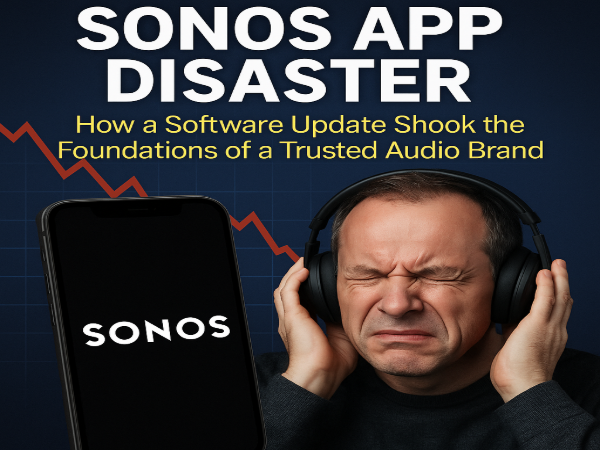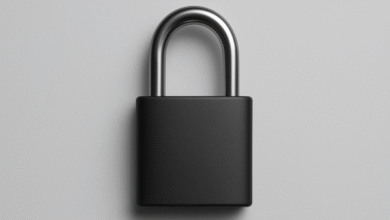Sonos App Disaster: How a Software Update Shook the Foundations of a Trusted Audio Brand
A Deep Dive into the Feature Failures, Customer Backlash, and Sonos’ Struggle to Regain Trust

The Sonos App Disaster refers to a critically flawed software update released in May 2024, which stripped essential features from Sonos’ premium audio ecosystem. Long-time users were left grappling with broken functionalities, missing capabilities like alarms and playlist editing, and erratic performance across their devices. This misstep sparked widespread outrage among loyal customers and triggered a series of financial, reputational, and organizational crises within the company. The disaster serves as a major case study in how software reliability is crucial to maintaining trust in even the most respected hardware brands.
Introduction: When Sound Went Silent
In May 2024, Sonos, a name synonymous with premium, whole-home audio systems, rolled out what it intended to be a forward-thinking upgrade to its mobile app. Instead, it launched one of the biggest tech failures in recent memory. Dubbed by users and media alike as the “Sonos App Disaster,” the update didn’t just cause glitches—it removed fundamental features, rendered expensive setups nearly unusable, and disrupted the seamless experience Sonos had built its reputation on for years.
What followed was not only a technical failure but a public relations nightmare that still reverberates through the company’s operations, finances, and user relationships. Let’s unpack how a single update nearly derailed one of the most trusted names in home audio.
The Rise of Sonos: A Legacy of Excellence
Before the disaster, Sonos had carved a niche in the audio industry with products that combined superior sound quality, sleek design, and unmatched multi-room functionality. Its app acted as a central control hub—essential for managing speakers, creating room groups, curating playlists, setting alarms, and more.
Sonos catered to both everyday users and audiophiles, offering reliability and intuitive control. The brand thrived not just on the strength of its speakers but on its ability to integrate music streaming, local libraries, and voice assistants into a unified, frictionless experience. That is, until the May 2024 update changed everything.
The Update That Broke Everything
The May 2024 app redesign was meant to modernize the user interface, boost performance, and prepare the ecosystem for upcoming hardware like the Sonos Ace headphones. Instead, it stripped away many of the functionalities users relied on daily:
Missing Alarms and Sleep Timers: Features essential to many users simply vanished, with no clear timeline for return.
No Playlist Editing: Users could no longer modify or save playlists, a basic function in any audio app.
Broken Speaker Grouping: Speakers would disappear from the app or fail to sync, making the hallmark multi-room experience a nightmare.
Glitches and Crashes: Many reported frequent app crashes, lag, and lost connection to their speaker systems.
Local Library Removal: For users who relied on local media playback rather than streaming services, the app became essentially useless.
This wasn’t just a few bugs—Sonos had fundamentally broken the way its customers interacted with their audio systems.
The User Backlash: Voices of Frustration
Loyal Sonos users, many of whom had invested thousands into their home audio setups, took to Reddit, social media, and forums to voice their dismay. The common sentiment was betrayal. People had come to trust Sonos for its reliability and seamless integration, and now their homes were filled with premium audio gear that didn’t work as promised.
Some users shared that they felt forced into using third-party apps or voice assistants to get basic tasks done. Others expressed anger over Sonos’ lack of transparency, slow response time, and tone-deaf marketing that ignored the crisis at hand.
Financial and Organizational Fallout
The app disaster wasn’t just a blow to Sonos’ reputation—it hit the company’s bottom line hard.
Stock Price Drop: Within weeks, Sonos lost nearly half a billion dollars in market value.
Layoffs: Over 200 employees were let go as part of a restructuring effort tied to the crisis.
Leadership Shake-Up: CEO Patrick Spence resigned in early 2025, and several other executives followed.
User Lawsuits: Disgruntled customers began organizing class-action lawsuits, alleging Sonos had knowingly pushed a broken app update that degraded their product experience.
In every measurable way—financially, reputationally, and operationally—Sonos was reeling.
The Apology and the Road to Redemption
Faced with mounting pressure, Sonos issued multiple public apologies and acknowledged the severity of the update’s impact. Interim CEO Tom Conrad led the charge in trying to rebuild trust. He promised transparency, faster updates, and a re-evaluation of Sonos’ product development pipeline.
Here’s how Sonos responded:
Feature Restoration Pledge: The company promised to return most of the missing features in future updates and has restored approximately 90% so far.
User Advisory Boards: New channels for user feedback were launched to better incorporate real-world use cases and accessibility needs.
Updated Roadmap: Sonos postponed certain hardware releases to focus entirely on software stability.
Leadership Accountability: Senior leadership voluntarily forfeited bonuses until customer satisfaction benchmarks were met.
Ongoing Issues and Lingering Distrust
Despite these efforts, many customers continue to report issues. While basic functionality has returned for some, users with complex setups still experience lag, speaker dropouts, and syncing failures. Android users, in particular, report persistent app crashes and connection problems.
The damage to Sonos’ brand—particularly among its core fanbase of audio enthusiasts—may take years to undo. Many users have moved to competitor platforms, and some refuse to update their apps in fear of further instability.
Lessons Learned from the Sonos App Disaster
There are critical takeaways from this disaster, not just for Sonos but for all tech companies:
Software Is Core, Not Accessory: For hardware brands, the user interface isn’t an afterthought—it’s the gateway to functionality.
Don’t Fix What Isn’t Broken: The redesign may have been aesthetically appealing, but it ignored the practical needs of existing users.
User Feedback Must Drive Development: Beta testing, especially among long-time users, is vital for rollout success.
Transparency Builds Trust: The initial silence and vague promises from Sonos added fuel to the fire.
Looking Ahead: Can Sonos Regain Its Footing?
Sonos still has a loyal user base and some of the best audio hardware on the market. Its willingness to take responsibility and gradually roll back issues shows commitment. But the road ahead is steep.
For many customers, the trust broken in 2024 may not be easily repaired. And in an increasingly crowded market—with companies like Bose, Apple, and Google stepping up their smart speaker offerings—Sonos cannot afford another slip-up.
Still, if Sonos continues to prioritize user needs, improve testing protocols, and communicate openly, it may be able to reestablish itself as the gold standard in smart audio systems.
Conclusion: A Sound Brand Undone by Silence
The Sonos App Disaster is a textbook example of how a single misstep in software development can derail even the strongest hardware brand. What was meant to be a step forward became a painful step back for thousands of users. And while Sonos has made progress in cleaning up the mess, the echoes of this disaster will reverberate for years to come.
It’s a hard lesson in the digital age: in a world where hardware and software are inseparable, you’re only as strong as your weakest app.



